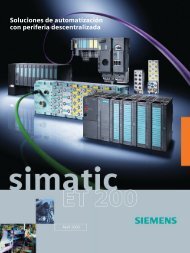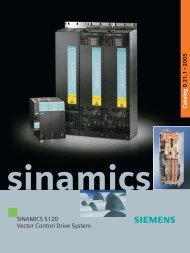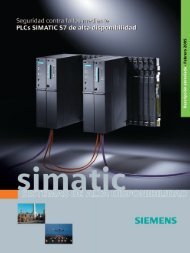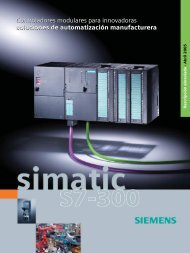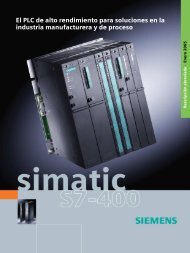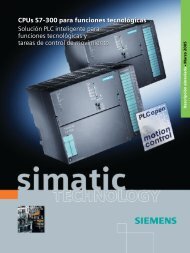Power supplies SITOP power LOGO!Power Catalog K T 10.1 2004
Power supplies SITOP power LOGO!Power Catalog K T 10.1 2004
Power supplies SITOP power LOGO!Power Catalog K T 10.1 2004
You also want an ePaper? Increase the reach of your titles
YUMPU automatically turns print PDFs into web optimized ePapers that Google loves.
Technical information and configuration<br />
Stabilized DC <strong>power</strong> <strong>supplies</strong><br />
■ Stabilized DC <strong>power</strong> <strong>supplies</strong> (continued)<br />
Linear stabilized <strong>power</strong> <strong>supplies</strong><br />
Unstabilized<br />
mains<br />
Block diagram: Linear regulator<br />
The linear regulator operates according to a conventional principle.<br />
The supply is provided from an AC supply system (one, two<br />
or three conductor supply).<br />
A transformer is used to adapt it to form the required secondary<br />
voltage.<br />
The rectified and filtered secondary voltage is converted into a<br />
stabilized voltage at the output by a regulation section. The regulation<br />
section comprises a final control element and a control<br />
amplifier. The difference between the stabilized output voltage<br />
and the unstabilized voltage at the filter capacitor is converted<br />
into a thermal loss in the final control element. The final control<br />
element functions in this case like a rapidly changeable ohmic<br />
impedance. The thermal loss that arises in each case is the<br />
product of output current and voltage drop over the final control<br />
element.<br />
This system is extremely adaptable. Even without any further<br />
modifications, several output voltages are possible. In the case<br />
of multiple outputs, the individual secondary circuits are generated<br />
from separate secondary windings of the input transformer.<br />
Some applications can only be resolved in accordance with this<br />
circuit principle. Especially when highly accurate regulation,<br />
minimal residual ripple and fast compensation times are required.<br />
The efficiency is, however, poor and the weight and volume are<br />
considerable. The linear regulator is therefore only an economical<br />
alternative at low <strong>power</strong> ratings.<br />
Advantages:<br />
• Simple, well-proven circuit principle<br />
• Good to excellent control characteristics<br />
• Fast settling time<br />
Disadvantages:<br />
• Relatively high weight and large volume due to the<br />
50 Hz transformer<br />
• Poor efficiency, heat dissipation problems<br />
• Low storage time<br />
Magnetic stabilizer<br />
Unstabilized<br />
mains<br />
Rectifier<br />
Transformer<br />
Ferro resonator<br />
Filtering<br />
electrolytic capacitor<br />
G_KT01_EN_00177<br />
Stabilized output<br />
voltage<br />
G_KT01_EN_00178<br />
Block diagram: Magnetic stabilizer<br />
Actuator<br />
in case of<br />
readjustment<br />
Vout<br />
stabilized<br />
Load<br />
Vout stabilized<br />
Load<br />
The complete transformer comprises two components. The socalled<br />
"ferro resonator" and a series connected auxiliary regulation<br />
section. The input winding and the resonance winding of the<br />
magnetic stabilizer are decoupled to a large extent by means of<br />
the air gap. The magnetic stabilizer <strong>supplies</strong> a well-stabilized AC<br />
voltage. This is rectified and filtered. The transformer itself is operated<br />
in the saturation range.<br />
The ferro resonator frequently has a linear regulator connected<br />
to the output to improve the control accuracy. Secondary pulsed<br />
switched-mode regulators are frequently also connected to the<br />
output.<br />
The magnetic stabilizer technique is reliable and rugged but is<br />
also large-volume, heavy and relatively expensive.<br />
Advantages:<br />
• Good to excellent control characteristics in combination with<br />
series connected linear regulators<br />
• Significantly better efficiency than a linear regulator alone<br />
Disadvantages:<br />
• The ferro resonator is frequency dependent<br />
• The <strong>power</strong> <strong>supplies</strong> are large and heavy due to the magnetic<br />
components<br />
Secondary pulsed switched-mode <strong>power</strong> <strong>supplies</strong>:<br />
Unstabilized<br />
mains<br />
Transformer<br />
Filtering<br />
Rectification<br />
G_KT01_EN_00179<br />
Switching<br />
transistor<br />
Control<br />
Secundary<br />
switched-mode<br />
regulator<br />
Block diagram: Secondary pulsed switched-mode <strong>power</strong> supply<br />
Isolation from the supply system is implemented in this case with<br />
a 50 Hz transformer. Following rectification and filtering, the energy<br />
is switched at the output by means of pulsing through a<br />
switching transistor in the filtering and storage circuit. Thanks to<br />
the transformer at the input, that acts as an excellent filter, the<br />
mains pollution is low.<br />
The efficiency of this circuit is extremely high.<br />
This concept offers many advantages for <strong>power</strong> <strong>supplies</strong> with<br />
numerous different output voltages.<br />
To protect the connected loads, however, care must be taken; in<br />
the event of the switching transistor breaking down, the full, unstabilized<br />
DC voltage of the filter capacitor will be applied to the<br />
output. This danger, however, also exists in the case of linear<br />
stabilized <strong>power</strong> <strong>supplies</strong>.<br />
Advantages:<br />
• Simple design and high efficiency<br />
• Multiple outputs, also galvanically isolated from one another,<br />
are easily implemented by means of several secondary windings<br />
• Fewer problems with interference than with primary pulsed<br />
switched-mode <strong>power</strong> <strong>supplies</strong><br />
Disadvantages:<br />
• The 50 Hz transformer makes the <strong>power</strong> <strong>supplies</strong> relatively<br />
large and heavy<br />
• The output ripple (spikes) correspond to those of a primary<br />
pulsed switched-mode <strong>power</strong> supply<br />
V out<br />
stabilized<br />
Load<br />
14<br />
Siemens KT<strong>10.1</strong> · <strong>2004</strong> 14/3




